As water scarcity increases around the globe, it’s vital that we look at the way we use water. It also provides us with an opportunity to look into alternative methods, such as using a greywater system, to meet our water demands.
This method of recycling water is one of the best ways to use less clean water, saving water for drinking or cooking.
Greywater systems are becoming more and more popular worldwide, especially in countries experiencing droughts or water shortages.
This article explores what greywater systems are and how you can use them in your own home to save water and money.
Table of Contents
What Is A Greywater System?
It’s important to highlight the difference between greywater and wastewater.
Wastewater is water that is linked to toilets and contains urine and feces.
Although it might not sound like it, greywater is clean and safe for irrigation and other purposes. It is the water that runs down the drain of a bath, sink, shower, dishwasher, and even washing machine.
Whilst greywater may contain oils, detergents, fats, and hair it is deemed safe for reuse in certain circumstances.
There are 2 main usages for greywater:
- Irrigation
- Toilet Flushing
Irrigation
Whether or not crops should use greywater is an ongoing debate. However, the World Health Organization has released multiple guides and regulations on using greywater in agriculture. However, these don’t exactly apply to you and how you’d use greywater.
When it comes to watering with greywater, installing an underground delivery system is the safest route. The system allows roots to absorb the nutrients in the greywater without you handling the greywater.
All plants can use the underground irrigation system, including vegetables and fruit trees. However, installing this type of irrigation can be expensive.
The other option is connecting a pipe to the greywater storage tank and directly watering your plants. This method is best for flower beds and other decor plants.
Toilet Flushing
With new dual-flush toilets, we are on the right track to reducing the amount of water we flush down our toilets. But each flush is still 1.6 gallons (6 Litres) of drinking or cooking water.
That may not seem like a lot, but on average, a household of 3 people flush their toilets 15 times a day. That’s 24 Gallons (90Ltrs) of water in a day and 720 Gallons (2700Ltrs) in a month. To put that into perspective, that’s roughly 5400 bottles of water.
Instead of flushing your toilets with clean water, filtered greywater can reduce your water bill and save water.
How Does A Greywater System Work?
It’s important to note that even water from sinks and baths can contain pathogens (bacteria, viruses, or tiny organisms). Safety is therefore something you need to keep in mind when dealing with greywater.
Greywater systems help by filtering the greywater so that it may be used again, without you coming in contact with the water.
A greywater system can be broken down into 4 main parts:
- Pretreatment
- Sand/Gravel Filter
- Storage
- Irrigation/Outlet
Pretreatment
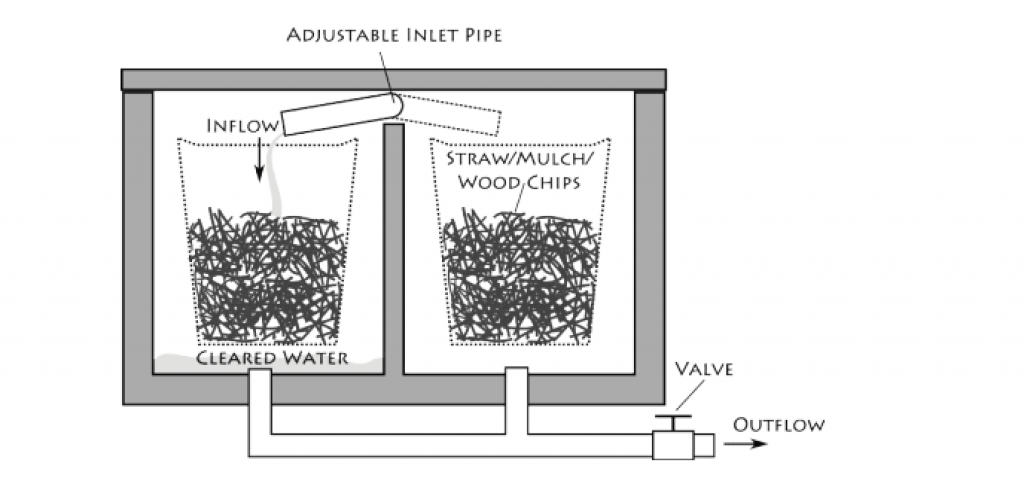
Source: WECF
Pretreatment is the first component of a greywater system. Whilst this part isn’t vital and can be left out, it’s both recommended and beneficial.
The greywater should be filtered through a biofilter first. The filter absorbs oils and fats in the water, preventing them from building up in the sand filters. If too much oil or grease builds in the sand filter, it can cause clogging or start to smell.
The biofilter is simple and consists of a permeable container and organic material. This material includes woodchips, reeds, mulch, or grass. The greywater would flow into the filter, through the material that catches the grease, and into the sand filter.
Sand/Gravel Filter

Source: WECF
Using sand is a great way to filter greywater. It’s easy to set up and maintain, and it uses gravity instead of a pump system. The sand filters out hair, debris, and bacteria, things the biofilter might have missed.
Sand filters often contain gravel as well. An effective filter consists of 3 layers stacked on top of each other:
- Gravel (Distrubution) – 20%
- Fine Sand (Filter) – 60%
- Gravel (Drainage) – 20%
The greywater flows over the top layer of gravel, catching any larger debris pieces. It then filters through the sand and out the bottom layer of gravel.
Storage
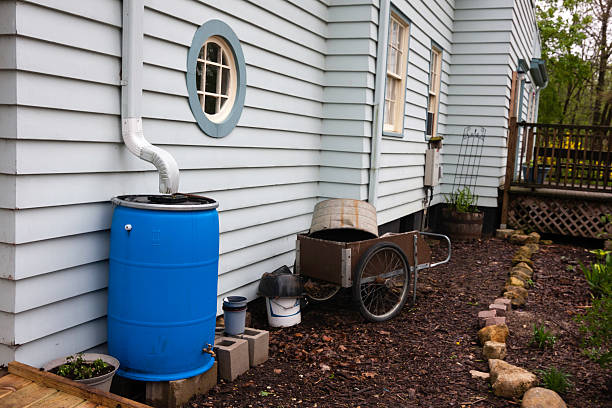
Source: Istock
The greywater flows into a tank or drum and is stored. Greywater shouldn’t stink, but this depends on a couple of factors.
One of the most significant factors is how long the greywater is stored. The longer you store greywater, the higher the chance of bacteria creating an odor. It would be best if you used greywater as soon as possible to prevent this. Either through flushing toilets or by discharging into the ground.
The other factor is the temperature that greywater is stored. Warmer temperatures allow for bacteria to flourish and the possibility of mold. Whilst colder temperatures prevent this, allowing for a longer storage time.
Irrigation/Outlet
The final part of the system depends on how you plan to use the greywater. After filtering, the water can be discharged quickly into the earth. Not only does this decrease water pollution, but it also releases the water back into the natural water cycle instead of a sewer system.
You could also use the water for irrigating plants, yes even as part of hydroponic setups. Later in this article, we’ll explore different irrigation methods that work well with greywater.
It’s also possible to have an outlet connected to your toilet system, allowing you to flush your toilets with greywater.
What Are The Benefits Of A Greywater System?
There are many ways in which a greywater system can be beneficial. This includes putting water back into the natural water table and nurturing your gardens. We can organize most of these benefits into 3 categories:
- Saving clean water
- Water and heat recycling
- Organic filtering
Saving Clean Water
According to a study in southern Brazil, installing a greywater system can save up to 42% clean water. This is because you would use no clean water to irrigate plants or for flushing toilets.
Thus, greywater systems are precious in drought or water-restricted countries.
Another study, conducted by Women in Europe for a Common Future (WECF), showed that 25% of household water comes from flushing toilets.
Water and Heat Recycling
The other 75% of the water used for washing and cleaning can be recycled as greywater.
Greywater systems prevent water from being flushed into the sewage and reaching a runoff that may be polluting the environment around it.
Instead, the system filters out the pollutants and puts the water straight back into the ground. This replenishes the groundwater level and puts the water back into the natural cycle.
It’s also possible to have your system retrieve heat from the greywater and put it back into your home. Achieved through a heat transfer, it moves the heat from the greywater system into your central heating system.
Organic Filtering
Greywater systems use organic and natural materials to filter your water for reuse. The biofilter contains materials that can decompose and the sand filter only needs to be changed every 5 to 10 years.
This means that the water does not need to be treated with chemicals such as chlorine before reusing. These chemicals can be harmful to the environment, especially in large quantities.
It’s important to note that the sand filter can’t filter out detergents effectively when using a greywater system. Most household cleaning detergents contain high levels of salt and boron and change the pH level of the water. This can be harmful to your garden if you reuse greywater for irrigation.
Here, you can find a list of safe cleaning products for greywater reuse.
Different Types Of Greywater Systems
Greywater systems vary depending on which components you install, how effective you’d like the system to be, and how compact it needs to be.
Below we talk about different systems and the benefits of each design.
High-Tech Greywater System
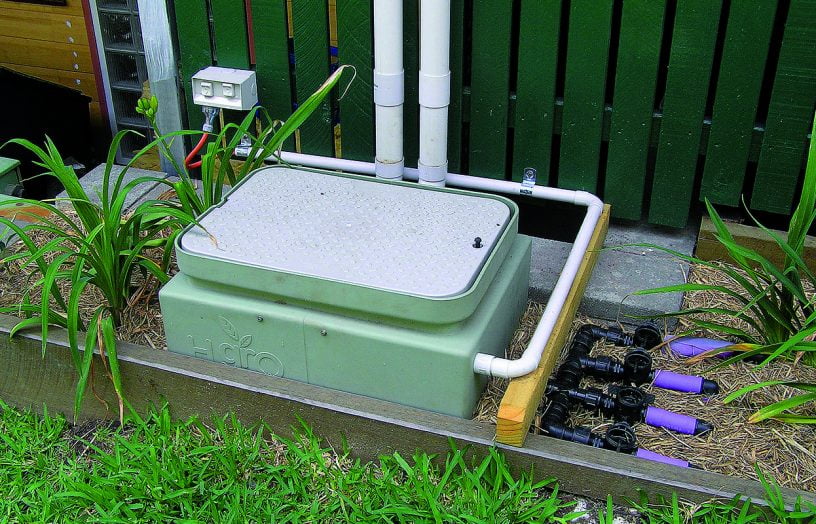
Source: Reuse.org
The most efficient and energy-saving systems are high-tech. This system will save the most amount of water and even recapture heat. In addition, they’re compact, and some are even small enough to fit into a broom cupboard.
High-tech systems are often manufactured as a kit or installed by the manufacturer. Whilst the high-tech system might sound like the perfect system, it comes at a cost.
High-tech systems are the most expensive systems on the market. They include costly filters that need to be replaced monthly and have parts that regularly need maintenance. Most systems also work with pumps which means that there is an energy consumption factor to them.
| Advantages | Disadvantages |
| Compact | Costly |
| Easy to install | High Maintainance |
| Efficient | Electricity Consumption |
Low-Tech Greywater System
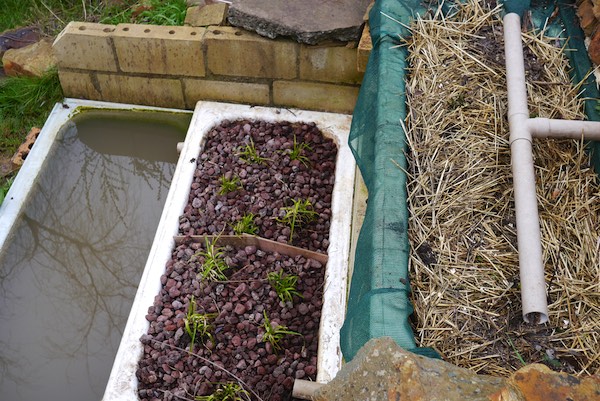
Source: milkwood
Low-tech systems are the systems you can build yourself. This includes all the components we mentioned above.
It’s cost-effective to create your biofilter and sand filter. With low-tech systems, you rely on gravity to move the water from one part of the system to the next.
They also offer a lot of customization that a high-tech system might not. This includes deciding how big you’d like the storage tank to be or what kind of irrigation system you’d like to install.
Low-tech systems are also low maintenance. For example, the sand filter needs to be changed every five years, depending on how efficient your biofilter is. However, as long as no grease clogs the sand filter, it has a long lifespan and doesn’t release an odor at all.
Because low-tech systems are DIY, their efficiency depends highly on how accurately you’ve installed the system. Leakages and water pooling up in the system are two issues that may occur if the pipes are not sealed correctly or installed at downward angles.
All the components of this type of system can be bulky. For example, a sand filter needs to be positioned higher than the storage tank for the water to drain correctly. With everything adding up, a low-tech system can take up a lot of space.
| Advantages | Disadvantages |
| Low Maintenance | Labour Intensive |
| Cost-Effective | Requires Space |
| No Installation Fee | Depends Heavily on Installation |
Wetland Greywater System

Source: earthactivisttraining
Wetland systems are the most eco-friendly and low-maintenance option for a greywater system.
The greywater flows into the system and is distributed across the surface bed. It then seeps through the raised wetland bed and into a layer of gravel for drainage. Bio and sand filters are not required, and the system already includes marsh plants such as reeds or tall grasses.
This system requires little to no maintenance. Woodchips on the surface bed capture the grease, and the roots take in nutrients from the sand. This system allows nature to do its thing and depends on gravity for water flow.
The only maintenance required includes changing the wood chips regularly and ensuring that the plants are healthy. It’s essential to change the wood chips and till the surface bed; otherwise, the system might release an odor. As the particles, fats, and other solids decompose, they supply the wetland with nutrients but can also start to smell.
| Advantages | Disadvantages |
| Low Maintenance | The System Is Slow |
| Cost-Effective | Doesn’t Work In All Climates |
| Eco-Friendly | Can Start To Smell |
| Decorative |
How Much Does A Greywater System Cost?
The cost of a greywater recycling system highly depends on the type of system you use. For example, a high-tech system requires monthly maintenance whilst the wetland system self regulates itself.
Aquality produces greywater systems and installs them for you, but they aren’t really feasible for residential use. The system alone costs $3970 – $4530 with an installation fee of $1320. Then, maintaining the system costs $200 to replace the membrane filter each month.
Systems like these are recommended for commercial properties or hospitality like guest houses or hotels.
Constructing a DIY greywater system is a lot cheaper. It costs as little as $30, depending on how intensive you’d like the system to be.
Installing 3-way valves to switch between wastewater and greywater for sinks can increase costs. Manually watering your garden is also cheaper than installing an underground irrigation system.
It’s important to note that it’s cheaper to install a greywater system when building a new house instead of fitting one into your existing home.
Greywater System Diagram
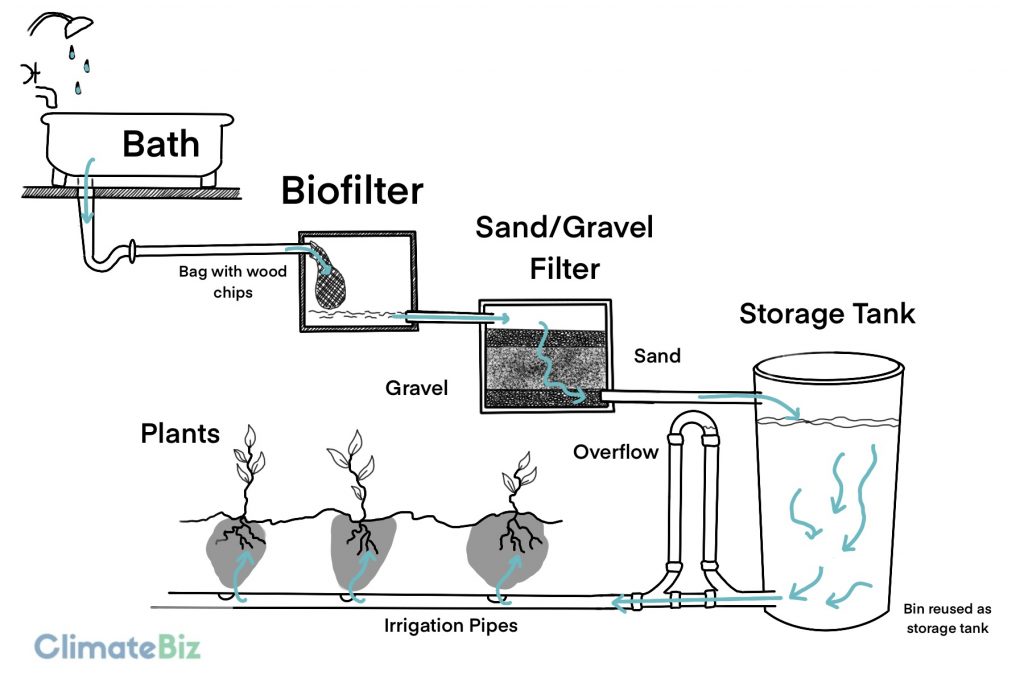
Above is a diagram showing a simple greywater system.
Water from baths and sinks flows through the biofilter bag and into the sand filter. There, it filters through the sand, removing any debris.
It then flows through into a storage tank. If you’re making your own system, you can repurpose a bin to store the water. Just make sure you seal all holes tightly.
The bin can have a simple overflow system attached.
The water then flows into the irrigation system, where it waters crops and reenters the water cycle.
Final Thoughts
Our homes use a lot more water than we might think. As water becomes less and less available to all humans around the globe, it becomes vital to protect this resource.
Greywater systems are one of the most effective ways to recycle water and save money. By installing them into your homes, you can save up to 40% on your water bill and become more environmentally friendly.
It may take time, labor, and money to install a greywater system, but it will pay itself off in the long run.
These systems recycle up to 75% of your water and can be used to irrigate plants and flush toilets.
If you’re looking at buying a new home, we highly recommend that you look for one that either has a greywater system installed or has the space for you to install one.
(Sketches can be attributed to the author of this article Dylan Crosbie)

